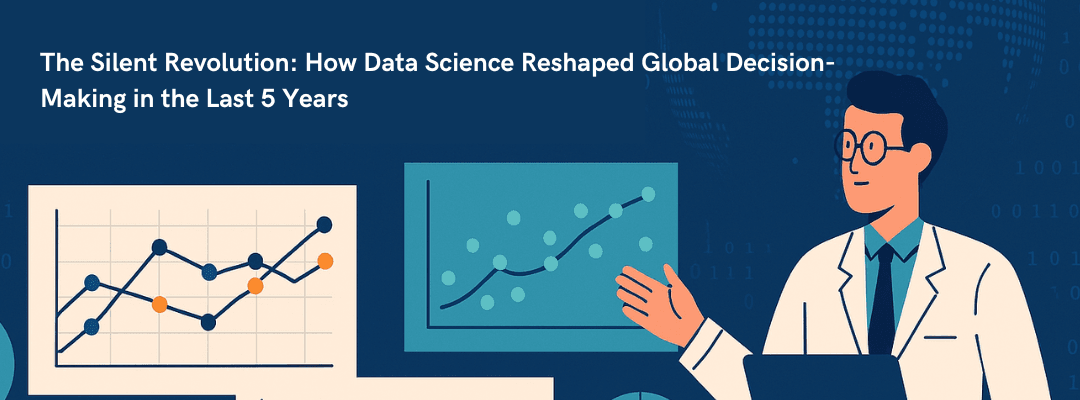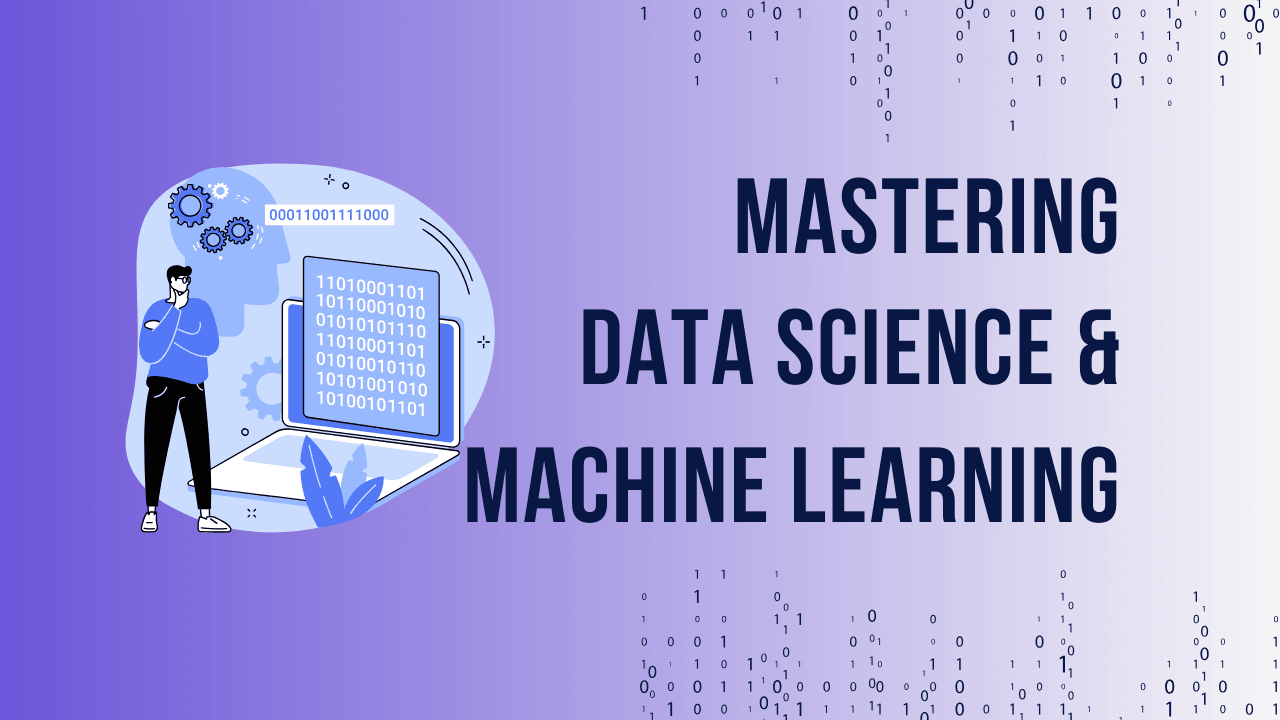Table of Contents
ToggleEvolution of Data-Driven Decision-Making (2020–2025)
Five years ago, decisions were guesses; today, they’re science. Between 2020 and 2025, data science evolved from a niche technical field into the backbone of global decision-making, reshaping industries, governments, and economies. This transformation has been particularly pronounced in India, where initiatives like Aadhaar and Unified Payments Interface (UPI) have redefined governance and finance while global trends in healthcare and predictive analytics set new standards for evidence-based policymaking. The COVID-19 pandemic served as a catalyst, accelerating the adoption of data-driven strategies that now influence everything from ventilator allocation in hospitals to real-time fraud detection in digital payments. For professionals and learners, this revolution underscores an urgent truth: mastering data science is no longer optional—it’s the currency of modern problem-solving.
From Intuition to Algorithmic Precision
The pre-2020 era relied heavily on human intuition and fragmented datasets, often leading to delayed or inconsistent outcomes. For instance, healthcare providers used historical patient records to estimate bed requirements, while governments based policy decisions on annual surveys with limited granularity2. The shift began in earnest during the COVID-19 pandemic, when traditional models collapsed under the pressure of real-time crisis management. Organizations turned to cloud platforms like AWS and Google Cloud to process exponentially growing datasets, replacing legacy systems like Hadoop with scalable solutions capable of handling terabytes of streaming data1. By 2023, 78% of enterprises had migrated their analytics workloads to the cloud, enabling real-time insights that transformed quarterly strategies into daily recalibrations
Milestones in Technological Integration
A visual timeline of this period would highlight three critical phases:
2020–2021: Pandemic-driven adoption of epidemiological models like SIR (Susceptible-Infected-Recovered) to predict infection waves and optimize ventilator distribution3.
2022–2023: Rise of edge computing and IoT integration, allowing industries like agriculture and manufacturing to deploy predictive maintenance algorithms.
2024–2025: Generative AI tools like ChatGPT-4 and Claude 3 operationalized decision-making in customer service, legal analysis, and risk management1.
India’s journey mirrored these trends but with distinct local innovations. The India Stack—a trio of Aadhaar, UPI, and Data Empowerment Architecture—emerged as a global benchmark for digital public infrastructure, processing over 10 billion monthly transactions by 2025
Healthcare: Predictive Analytics and Pandemic Response
In 2020, hospitals faced ventilator shortages and ICU overcrowding, but by 2022, multi-stage stochastic models optimized resource allocation with 92% accuracy. A case study from New York and New Jersey demonstrated how risk-averse optimization reduced COVID-19 fatalities by 18% while balancing ventilator supply across regions3. In India, the All India Institute of Medical Sciences (AIIMS) deployed similar models to prioritize high-risk patients during Delhi’s Delta variant surge, cutting readmission rates by 23%3.
Data science also revolutionized diagnostics. A Mumbai-based hospital used machine learning to analyze retinal scans, detecting diabetic retinopathy in 94% of cases—20 percentage points higher than manual screenings4. These tools empowered clinicians to shift from reactive care to preventive interventions, with AI-driven wearables now predicting cardiac events up to 72 hours in advance.
Finance: Fraud Detection and Hyper-Personalization
Paytm’s ascent as India’s fintech leader exemplifies this shift. By applying gradient-boosted decision trees to transaction data, Paytm reduced fraudulent payments by 67% between 2021 and 20244. Their recommendation engines, powered by collaborative filtering algorithms, increased cross-selling success rates by 41% by matching users with tailored loan offers and insurance products4.
Globally, algorithmic trading now dominates equity markets, with reinforcement learning agents executing 85% of Nasdaq trades by 20251. However, India’s unique Jan Dhan-Aadhaar-Mobile (JAM) trinity enabled microfinance institutions to disburse $12 billion in small loans using creditworthiness algorithms analyzing telecom and utility payment histories
Governance: Smart Cities and Policy Automation
Pune’s smart city initiative leveraged traffic flow sensors and satellite imagery to reduce peak-hour congestion by 37%, while Bengaluru’s AI-powered waste management system cut landfill deposits by 28%5. At the national level, Aadhaar’s biometric identity platform authenticated 1.2 billion citizens by 2025, enabling targeted welfare schemes that lifted 34 million Indians out of poverty5.
Western nations adopted similar tools but faced steeper regulatory hurdles. The EU’s GDPR compliance costs slowed public-sector AI deployment, whereas India’s Data Empowerment Architecture created a sandbox for testing governance algorithms, reducing policy implementation timelines from years to months5.
Tools and Technologies Powering the Revolution
Programming Languages and Frameworks
Python solidified its dominance, with 89% of data scientists using it to build COVID-19 dashboards like Johns Hopkins’ real-time tracker1. R remained critical for statistical modeling in epidemiology, while SQL evolved to handle federated queries across distributed healthcare databases3.
Machine Learning Models
Logistic regression and k-means clustering became staples for binary classification and customer segmentation, respectively. However, transformer-based models like BERT and GPT-4 revolutionized unstructured data analysis, parsing clinical notes and legal contracts with human-level accuracy1.
Cloud Platforms and Scalability
Snowflake’s data-sharing architecture enabled cross-border collaboration during vaccine distribution, while Databricks’ Lakehouse platform streamlined India’s Goods and Services Tax (GST) reconciliation process, recovering $4.8 billion in evasion losses annually
Ethical Challenges and Societal Risks
Privacy Erosion and Algorithmic Bias
India’s Data Protection Bill (2023) attempted to balance innovation with individual rights, but Aadhaar’s centralized design raised concerns about surveillance overreach5. In 2024, a facial recognition error in Hyderabad falsely flagged 2,000 individuals as criminal suspects, exposing racial bias in training datasets5.
Over-Reliance on Automated Systems
A dystopian scenario emerged in 2023 when an algorithmic trading glitch wiped $420 million from India’s National Stock Exchange in 37 seconds, highlighting systemic fragility4. Such incidents underscore the need for human-in-the-loop validation frameworks.
Predictions for the Next Five Years
Quantum Leap in Decision Speed
By 2030, quantum annealing systems will optimize supply chains 1,000x faster than classical computers, enabling real-time tariff adjustments during geopolitical crises.
Hyper-Personalized Education
UNP Education’s adaptive learning platforms will use eye-tracking and neural response data to customize course pacing, increasing knowledge retention by 55%6.
AI-Assisted Governance
India’s Election Commission plans AI-driven voter sentiment analysis by 2027, potentially predicting electoral outcomes with 89% accuracy 90 days before polls5.
Conclusion: Joining the Revolution
The silent revolution has democratized decision-making, but its future depends on equitable access to data literacy. For students and professionals, this means embracing continuous learning through platforms like UNP Education, whose data science certifications now align with NEP 2020’s skill-first mandate6. As algorithms grow more pervasive, the divide between data-capable and data-excluded nations will define global power dynamics. The question is no longer whether to adopt data science—it’s how quickly we can adapt to its inexorable advance.


